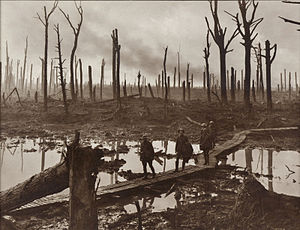Third Battle of Ypres
| Battle of Passchendaele Third Battle of Ypres |
|||||||
|---|---|---|---|---|---|---|---|
| Part of the Western Front of the First World War | |||||||
 Australian gunners on a duckboard track in Château Wood near Hooge, 29 October 1917. Photo by Frank Hurley. |
|||||||
|
|||||||
| Belligerents | |||||||
|
|
|
||||||
| Commanders and leaders | |||||||
|
|
|
||||||
| Strength | |||||||
| 50 British, 6 French divisions | 77–83 German divisions | ||||||
| Casualties and losses | |||||||
| Disputed, see Casualties section 200,000–448,614 |
Disputed, see Casualties section 217,000–410,000 including 24,065 prisoners. |
||||||
|
Passchendaele/Passendale, a Belgian village in the Zonnebeke municipality of West Flanders province.
|
|||||||
The Battle of Passchendaele (Third Battle of Ypres, Flandernschlacht and Deuxième Bataille des Flandres) was a major campaign of the First World War, fought by the Allies against the German Empire. The battle took place on the Western Front, from July to November 1917, for control of the ridges south and east of the Belgian city of Ypres in West Flanders, as part of a strategy decided by the Allies at conferences in November 1916 and May 1917. Passchendaele lay on the last ridge east of Ypres, 5 miles (8.0 km) from a railway junction at Roulers, which was vital to the supply system of the German 4th Army. The next stage of the Allied plan was an advance to Thourout–Couckelaere, to close the German-controlled railway running through Roulers and Thourout.
Further operations and a British supporting attack along the Belgian coast from Nieuwpoort, combined with Operation Hush (an amphibious landing), were to have reached Bruges and then the Dutch frontier. The resistance of the 4th Army, unusually wet weather, the onset of winter and the diversion of British and French resources to Italy, following the Austro-German victory at the Battle of Caporetto (24 October – 19 November), enabled the Germans to avoid a general withdrawal, which had seemed inevitable in early October. The campaign ended in November, when the Canadian Corps captured Passchendaele, apart from local attacks in December and the new year. In 1918, the Battle of the Lys and the Fifth Battle of Ypres were fought before the Allies occupied the Belgian coast and reached the Dutch frontier.
...
Wikipedia

